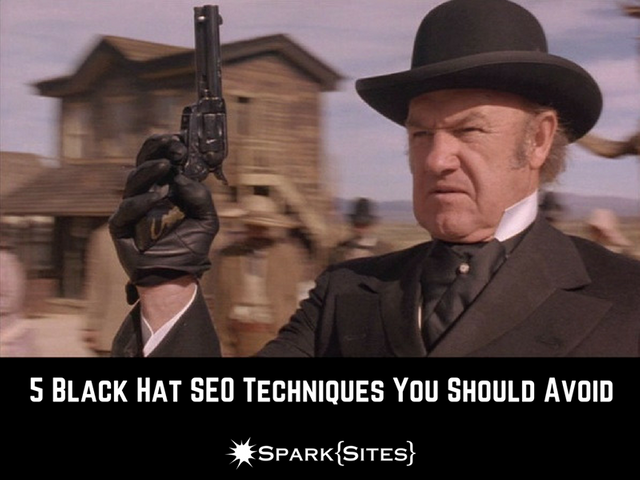
Have you ever watched an old western movie before? In a western the good guy a lot of times can be seen wearing a white hat, while on the other hand the “Most Wanted” guy is donning a black hat. When it comes to SEO, search engines have coined good / bad SEO techniques with the same terminology.
White hat SEO shows search engines that you are trying to improve your search ranking by using honest, pure content that still shows users what they are searching for.
To contrast, black hat SEO tricks are considered cheating, unfair and annoying for users. In any good western film, the black hatted bad guy always winds up in jail.
Likewise, there are serious consequences for those who delve into black hat tricks. We want to help you steer clear of putting a black hat on your website, so here are 5 black hat SEO techniques you should avoid:
- Keyword Stuffing
- Hidden Text
- Cloaking
- Social Media Spamming
- Link Bait-and-Switch
Keyword Stuffing
Lets say you’ve come up with a list of keywords that you think potential clients might be searching for. Keyword stuffing would be taking all those keywords and trying to stuff them anywhere you can in your content, alt. text on images, etc. You might see a bump in your ranking at first, but it won’t last long. While keywords may be important, having content that reads well is just as necessary. Think about if you were researching good places to take a yoga class. Wouldn’t it be annoying if all the content on the website you searched for looked like this:
Come visit our yoga class! We are the best yoga class in town. If you want to experience the best yoga, come to the best yoga class in town. We promise to provide the best yoga for your body. Our yoga is the best!
Okay. We get it. Your yoga classes are the best in town and you’re trying to be #1 on your Google ranking. Not cool man.
Hidden Text
Hidden text is the trick of adding more content and keywords to your website but in a way that it’s unseen to the user. Someone might add “best yoga, best yoga, best yoga, best yoga…” to the bottom of their website, but will make the text the same color of the background so it goes unseen but still gets the added keyword boost in their ranking. This is one of those black hat tactics that make us scratch our head. Why would you take the extra time to add all that hidden text to your website? Plus it’s a waste of time because adding hidden text will only hurt you in the long-run. Despite the chance it won’t effect your user very much, it’s still shady and considered cheating.
Cloaking

While we’re in the vein of bad guy apparel, how sketchy is a cloak!? Darth Vader, Lord Voldemort, the Joker they all wear some sort of a cloak.
Similarly, using cloaking to boost your SEO is sketchy. Cloaking would be coding your website with keyword rich content for your SEO, but then providing users with something you are trying to advertise to them. Or you can be a huge jerk and cloak your site with keywords that have nothing to do with what you’re actually selling. Wouldn’t be annoying if you were searching for the best yoga in your town, but clicked on a website that was trying to sell you an elliptical for your home?
Social Media Spamming
How many times have you gotten a notification on Instagram or Facebook from someone who left a comment on your post that looked like this:
Hey! Cool post. See more tips for how to be better at yoga at my website www.thisisbadseo.com
This is just a nuisance right? It’s cheap to comment on other people’s posts with the goal of deriving clicks from their hard work to your website. It’s not a fruitful tactic and you end up not only looking shady, but desperate as well.
Link Bait-and-Switch
We know that inbound links are helpful for a great search engine ranking. Inbound links are links on other websites that point to yours. Typically people are linking to your website because the content on your website coincides with whatever content is on their own.
Think about how annoying this would be: you’re doing a blog post on local places that promote better health. You pick three different places that come up when you type “best local health practices.”
One of the places that pops up appears to be a yoga center in town. You place a link in your blog that takes users to that website. Now the person who made the website is getting all these inbound links to their page and then sneakily completely changes their content to advertise a totally different product. How annoying is it for you now, that the link you posted in your blog has nothing to do with your post. This tactic can quickly lose you supporters.
Avoid Black Hat SEO Techniques
Almost anything that’s bad for you might be awesome at first but have long term consequences, like eating a donut every morning or playing too many video games. If you use any black hat SEO techniques, you might see your ranking go up at first, but Google isn’t dumb. In fact Google is constantly changing it’s algorithms to be able to detect shady SEO tricks.
If Google detects you’re using black hat SEO, your website could be penalized or even banned from the search engine. A banned website means zero traffic and a decreased chance to make sales. The bad guy never wins in the end!
Congratulations @grantnieddu! You received a personal award!
You can view your badges on your Steem Board and compare to others on the Steem Ranking
Vote for @Steemitboard as a witness to get one more award and increased upvotes!
Downvoting a post can decrease pending rewards and make it less visible. Common reasons:
Submit